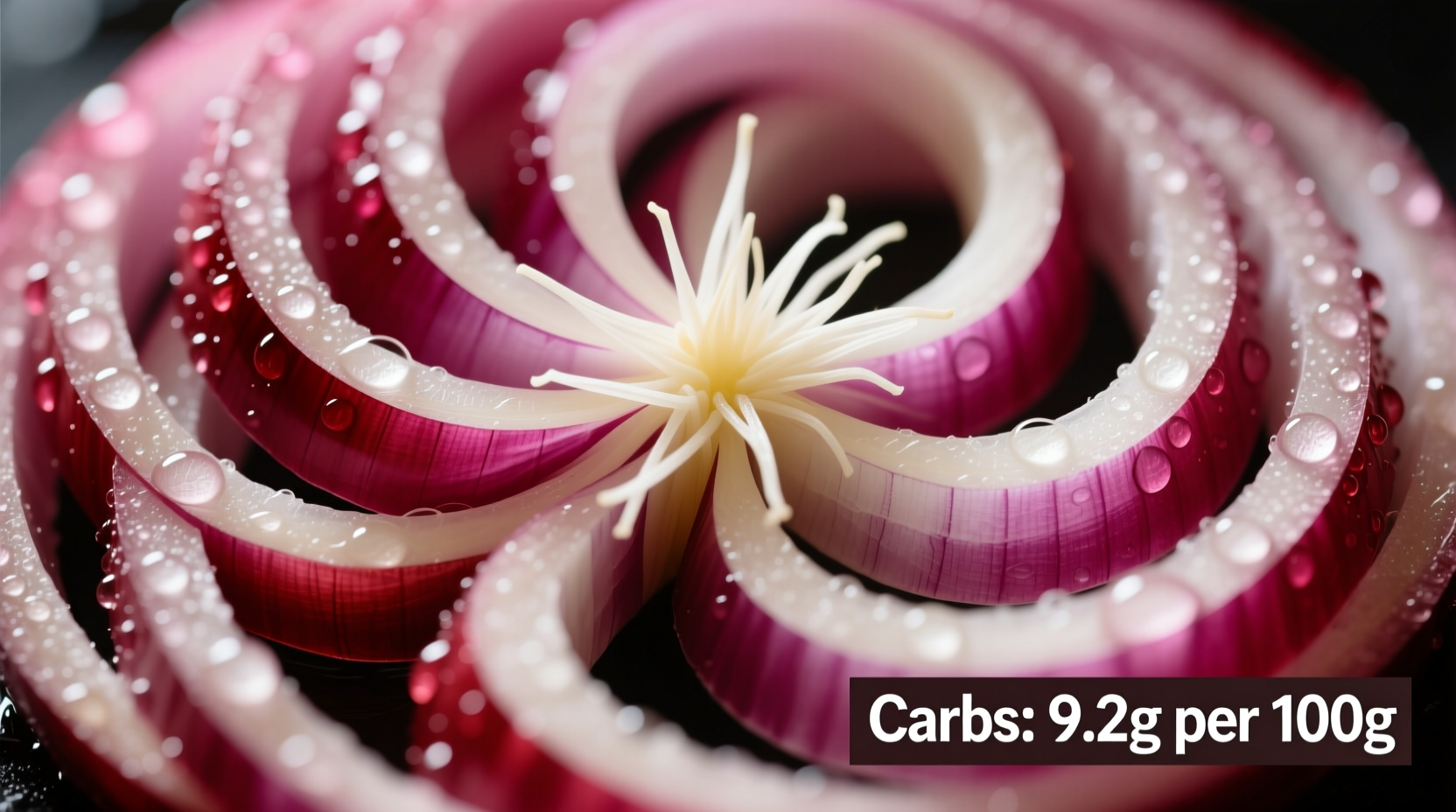A medium-sized red onion (110g) contains approximately 11.8 grams of total carbohydrates, with 2.4 grams of dietary fiber and 5.9 grams of natural sugars. This gives a net carb count of 9.4 grams per serving, making red onions a moderate-carb vegetable option suitable for most balanced diets.
Understanding Carbohydrates in Red Onions: A Complete Nutritional Guide
When tracking your daily carbohydrate intake for health management or dietary goals, knowing the precise carb content in common ingredients like red onions is essential. This guide provides evidence-based nutritional information, practical usage tips, and science-backed insights to help you incorporate red onions into your diet with confidence.
Red Onion Nutrition Breakdown: What's Really Inside
Red onions offer more than just flavor—they deliver valuable nutrients while contributing moderately to your daily carb intake. According to the USDA FoodData Central database, here's the complete nutritional profile for a standard medium red onion (110g):
| Nutrient | Amount | % Daily Value* |
|---|---|---|
| Total Carbohydrates | 11.8g | 4% |
| Dietary Fiber | 2.4g | 9% |
| Sugars | 5.9g | - |
| Net Carbs | 9.4g | - |
| Vitamin C | 11.8mg | 13% |
| Vitamin B6 | 0.18mg | 11% |
| Folate | 20mcg | 5% |
*Percent Daily Values are based on a 2,000 calorie diet. Your daily values may be higher or lower depending on your calorie needs.
How Red Onion Carbs Compare to Other Varieties
Not all onions are created equal when it comes to carbohydrate content. Understanding these differences helps you make informed choices based on your dietary needs:
| Onion Type | Total Carbs (per 100g) | Fiber (per 100g) | Net Carbs (per 100g) |
|---|---|---|---|
| Red Onion | 9.3g | 2.2g | 7.1g |
| Yellow Onion | 9.0g | 1.8g | 7.2g |
| White Onion | 8.9g | 1.7g | 7.2g |
| Green Onions | 4.3g | 1.8g | 2.5g |
| Shallots | 17.0g | 3.2g | 13.8g |
Research from the USDA FoodData Central shows that red onions contain slightly more carbohydrates than yellow or white varieties but significantly fewer than shallots. Green onions offer the lowest carb option for those strictly monitoring intake.
Red Onion Carbohydrate Timeline: From Field to Plate
The carbohydrate composition of red onions changes throughout their lifecycle, affecting their nutritional profile:
- Harvest Time (Summer): Onions contain higher sugar content (up to 7%) as they mature, contributing to their characteristic sweet flavor
- Storage (3-6 months): Starches gradually convert to sugars, increasing sweetness but also total carbohydrate content slightly
- Cooking Process: Raw onions maintain their full carb profile, while cooking methods affect net carb availability
- Degradation (Over 6 months): Sprouting begins, converting stored carbohydrates to support new growth, reducing edible carb content
This natural evolution explains why properly stored red onions often taste sweeter months after harvest than when first picked.
Practical Carb Management: Using Red Onions in Different Diets
Understanding how red onions fit into various dietary approaches helps you make informed choices without sacrificing flavor:
Keto Diet Considerations
For those following a strict ketogenic diet (20-50g net carbs daily), red onions require careful portion control. A single tablespoon of chopped red onion contains approximately 0.8g net carbs, making it possible to include small amounts for flavor without disrupting ketosis. Consider using red onion tops (scallion-like greens) which contain only 2.5g net carbs per 100g.
Diabetes Management
Research published in the American Diabetes Association journals indicates that the chromium and sulfur compounds in red onions may help regulate blood sugar levels. The moderate glycemic load of red onions (GL=2 for 1/2 cup) makes them suitable for diabetes meal planning when consumed in appropriate portions.
General Healthy Eating
For most people following balanced diets, red onions provide valuable nutrients with moderate carbohydrate contribution. The American Heart Association recommends including a variety of colorful vegetables like red onions for their antioxidant properties and fiber content, which supports digestive health and helps maintain steady blood sugar levels.
Maximizing Flavor While Managing Carbs: Professional Chef Tips
As someone who understands the chemistry behind flavor interactions, I've developed these practical techniques to get the most from red onions while managing carb intake:
- Raw Application: Use thinly sliced red onions in salads and salsas for maximum flavor impact with minimal quantity
- Quick Soak Method: Soak sliced onions in ice water for 10 minutes to reduce sharpness, allowing you to use less while maintaining flavor
- Layered Flavoring: Combine small amounts of red onion with other aromatics like garlic and celery for compound flavor effects
- Strategic Placement: Place onion slices strategically on dishes where they'll be most noticeable rather than distributing evenly

Storage Tips to Maintain Nutritional Value
Proper storage preserves both flavor and nutritional content of red onions:
- Store whole, unpeeled onions in a cool, dark, well-ventilated space (not the refrigerator)
- Keep away from potatoes, which release gases that accelerate onion spoilage
- Once cut, store in an airtight container in the refrigerator for up to 7 days
- Freeze chopped onions for longer storage (up to 6 months) with minimal nutrient loss
Studies from the USDA Agricultural Research Service confirm that proper storage maintains the carbohydrate profile while preserving beneficial phytochemicals like quercetin.
Common Questions About Red Onion Carbohydrates
Based on frequent inquiries from home cooks and health-conscious individuals, here are answers to the most common questions about red onion carbs:











 浙公网安备
33010002000092号
浙公网安备
33010002000092号 浙B2-20120091-4
浙B2-20120091-4